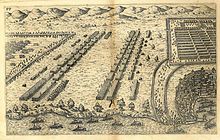Battle of Thapsus
| date | April 6, 46 BC Chr. |
|---|---|
| place | at Thapsus in North Africa |
| output | Caesar's victory |
| Parties to the conflict | |
|---|---|
|
Caesarians |
Senate Party |
| Commander | |
| Troop strength | |
| 20,000 legionaries, 2,000 archers and slingers, 1,200 horsemen | 28,000 legionaries, 12,000 Gallic, Iberian and Numidian horsemen, 64 war elephants |
| losses | |
|
1,000 |
10,000 dead, more than 10,000 wounded and prisoners |
The battle of Thapsus on April 6, 46 BC. BC (on February 2nd after the calendar reform of Gaius Iulius Caesar ) was a battle in the Roman Civil War .
prehistory
During the civil war between Caesar and Pompey (49-45 BC), Pompey's Senate Party initially succeeded in asserting itself in the province of Africa and allying with Juba I of Numidia . After Caesar had secured the east of the empire by his victory at Pharsalus over Pompey, he first returned to Italy and prepared another campaign to smash the remains of the Senate party in North Africa. While preparing for the invasion, one of his veteran legions mutinied. In exchange for their support, the soldiers had been made great promises (land allocations, etc.), which, however, years after their first victory in the civil war, had still not been fulfilled. Caesar could ultimately by exceptional modesty and humble request for support of the Legion for his men one bring another campaign back under control. The invasion was driven forward accordingly and possibly started hastily. Due to bad weather, the ships were widely dispersed and only a fraction of Caesar's men finally landed in December 47 BC. In the province of Africa.
Due to the hectic preparations, few supplies had been carried, which did not improve the situation. Titus Labienus , a former comrade in arms and confidante of Caesar, now fought on the side of the Senate Party and had been entrusted with the command of the Numidian cavalry. With constant attacks, the Numidian cavalrymen prevented any attempt to procure supplies. Caesar then led half of his army inland to conquer some desert cities and to secure their supplies. Labienus, whose troops were greatly outnumbered, used the greater mobility of his units to inflict a crushing defeat on Caesar's troops. It was only through a desperate frontal attack that Caesar was finally able to buy enough time to retreat. The survivors made it back to the coast with great difficulty.
For the next few months, Caesar's army holed up in their camp on the coast with little food. The army of the Senate Party had drawn up in front of the camp and was so superior that Caesar was forced to include the sailors of his ships as infantrymen. The Senate Party lined up in battle every day, but Caesar refused to accept the battle.
The situation only improved when further reinforcements arrived from Italy, whereupon Caesar left the camp again to force a battle on favorable terrain by attacking surrounding cities of the Senate Party.
The battle

Quintus Caecilius Metellus Pius Scipio continued after the assassination of Pompey in 48 BC. The fight against Caesar continued. After Caesar had landed, he followed Caesar to Thapsus (at Cape Ras Dimas south of Carthage ) and stood in battle order. Caesar was trapped on an isthmus because there was a lake on one side and the sea on the other. Metellus Scipio included him at the top of the headland, Lucius Afranius along with Juba at the bottom. On this narrow strip, however, it was not possible for the Republicans to play out their superior cavalry . Caesar turned to Metellus Scipio first, but hesitated to attack. Rumors about the alleged luxury in the camp of the Senate Army angered the badly battered and half-starved legionnaires of Caesar. The troops were impatient and a trumpeter blew without orders to attack. Immediately the soldiers marched towards the enemy. Metellus Scipio's troops were inferior across the board. The war elephants fled the shelling of the Caesarian archers and killed their own soldiers. After the Bellum Africum , Caesar himself rode in the first row and called Felicitas , the goddess of luck. According to Plutarch , however, Caesar did not take part in the battle because an epileptic attack prevented him.
When Metellus Scipio's army was defeated, Caesar turned to Juba I of Numidia and Lucius Afranius, who was allied with Scipio, and also destroyed them. The victory was complete, and Caesar's forces killed many of the fleeing soldiers. Marcus Porcius Cato the Younger committed suicide a little later, because he would rather die than owe his life to the grace of Caesar.
consequences
With the victory, Caesar was able to secure his rule in the province that is important for Rome's grain supply and annex the kingdom of Numidia.
Individual evidence
- ^ A b Nic Fields: Julius Caesar. Leadership, Strategy, Conflict. Osprey Publishing, Oxford 2010, ISBN 978-1-8460-3928-7 , p. 29.
- ^ Spencer C. Tucker: Wars That Changed History. 50 of the World's Greatest Conflicts. ABC-CLIO, 2015, ISBN 978-1610697866 , p. 118.
